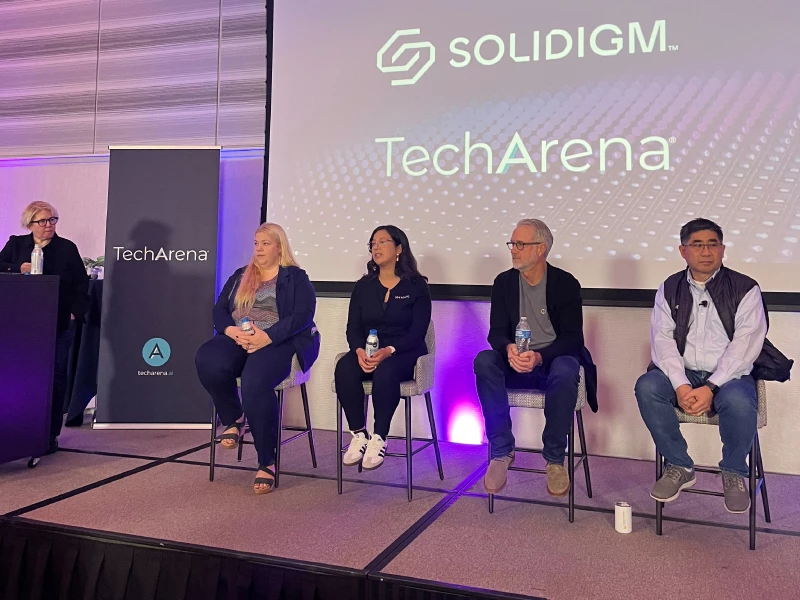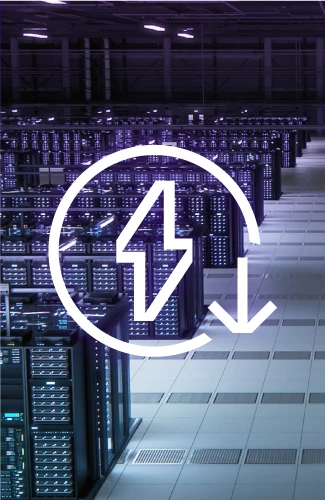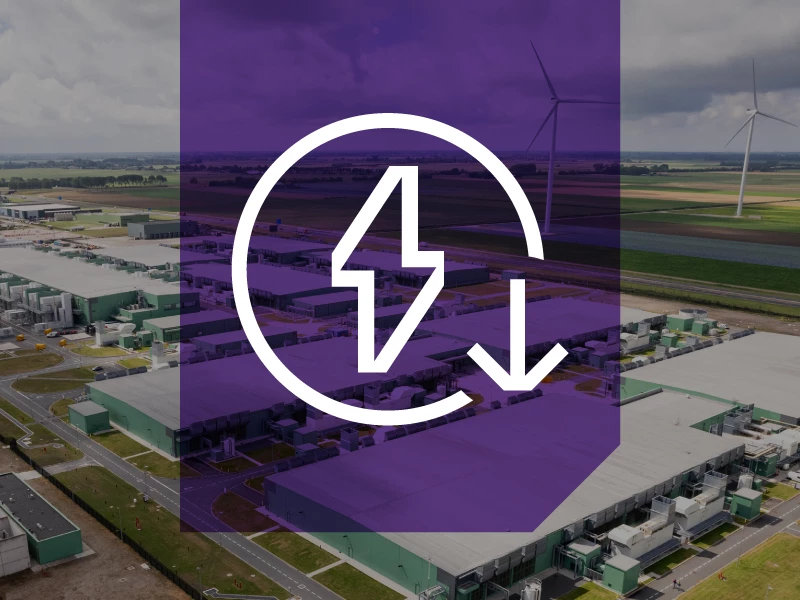Sustainability in Cloud Services with OVHcloud's Grégory Lebourg
TechArena podcast hosted by Allyson Klein and Jeniece Wnorowski
Join TechArena’s Allyson Klein and Jeniece Wnorowski of Solidigm as they discuss ways OVHcloud provides cloud computing world-wide using a vertically integrated model. Guest Grégory Lebourg speaks about how saving resources globally is good for the environment, but it's good for your business as well. Since energy efficiency and carbon footprint are hot topics, especially in Europe, OVHcloud has pioneered ways to prioritize frugality in terms of water usage, power usage, and infrastructure usage. Listen to the podcast to learn more.
Listen to the podcast
Audio Transcript
This transcript has been edited for clarity and conciseness
Narrator: Welcome to the TechArena, featuring authentic discussions between tech's leading innovators and our host, Allyson Klein. Now, let's step into the arena.
Allyson Klein: Welcome in the arena. My name is Allyson Klein, and I am so excited because it's time for another Data Insights interview, and that means Jeniece Wnorowski is back with me from Solidigm. Jeniece, welcome to the show.
Jeniece Wnorowski: Thank you, Allyson. It's a pleasure to be back.
Allyson: Jeniece, what have you been up to, and what's on bat for today?
Jeniece: It's been the usual, right? I've talked to a lot of different partners and customers about AI, but I'm very excited today to have with us Grégory Lebourg with OVH. Super excited to be able to talk with OVH today. OVH is actually a leading supplier of cloud services across the globe, so they aren't just a supplier in Europe, they are global. And I'd love to just turn it over to Greg in just a moment, so we can talk a little bit more about the company and the markets in which you operate.
Allyson: Welcome to the show, Grégory.
Grégory Lebourg: Thank you. Thank you, Jeniece. Thank you, Allyson. I'm super excited to be on that show as well. So in a nutshell, my role within OVH cloud is; I'm the global environmental director. Long story short, I'm in charge of putting together OVH cloud environmental strategy and policy, and to turn that into concrete projects, programs that we follow to reach the goals that we have set. As you've mentioned, Jeniece, OVH cloud is a pure player in the cloud market. It's a cloud service provider. We are a French-based company, but we have a worldwide footprint. We operate with our own infrastructure in nine countries, with 43 data centers, and obviously, the number of customers we have, since our foundation has increased a lot and now we have hit 1.6 million customers spread [across] 140 countries. So on that market, which is the cloud service market, we do provide all the flavors of cloud in terms of IaaS, PaaS, and to some extent, SaaS. And we do operate as well, private cloud platforms and public cloud platforms.
Allyson: When you consider the complexity of planning data center build out, it's becoming more and more important to focus on efficiency. And I'm so glad that you're on the show, given your purview at OVH. It's not just enough now to maximize return on resources, but also ensure that you're delivering on sustainability goals. And how have you seen this change, Grégory, over the last five years in the market?
Grégory: It's a very good point that you raise, Allyson, because the environmental agenda and the economical agenda, at one point, they converge, right? Saving resources globally is good for the environment, but it's good as well for your business. That's a fact. The big change, and this is a principle, right? The big change we've witnessed over the last five years is more about the market demand in terms of sustainability. If you look at the numbers of RFPs on the market, where are their multi-criteria decision-making process, the weight of the environmental topics, and I would say corporate social responsibility globally is very important. You know, if we look at some figures on that, for example, in the public sector in Europe, the ranking, the weight of everything that relates to corporate social responsibility is 20% of the decision-making process. In the private sector, it's more in the range of 10 to 12%. But we see that weight increasing. So the market is there, and the customers are really demanding on that front. That's one side of the story. On the other hand, of the spectrum, there is the regulation as well. And we see a lot of pressure, in particular in Europe, being put on being frugal, on being less impacting on the environment, in the way we operate our business, in the way we design things and services. So on both sides of the story, we see a lot of traction on that field.
Jeniece: So OVH is really known as a leader in compute sustainability, as you just alluded to, Grégory. But what is the philosophy that really drives your management perspectives for this?
Grégory: Okay, so a bit of history, maybe, to tackle that point. We have to go back to the very foundation of the company. So the company was founded back in 1999. It was funded by Octave Clabard. Octave is still the chairman of the board of the company. Even though we became public back in 2021, it's still, I would say, a family-owned business. This is very important to understand the philosophy because of that. We are in an industry which is very capex intensive. Those hardware platforms, those servers, they call out for a lot of investment. During more than 16, 17 years almost, the company was self-funded. You can imagine the amount of frugality and the amount of creativity of technology bridge they had to put in place to make sure that they would keep up with the growth of their activity being self-sufficient in terms of cash. The very foundation of the company is really based on the idea of frugality and the idea as well of being completely free from others, completely independent. This is why very early in the stage of the development of the company, they decided to put in place a vertical integrated model, an industrial vertical integrated model. This is quite unique in our industry because we design, but we build our own servers, the one that we operate in our data centers. The beauty of this principle of freedom, of independence is that we control the whole value chain. By controlling the whole value chain, you can easily address all the part of that chain, making sure that you don't create loss, you don't create unnecessary, I would say margins, for example, and you are able to propose services at the right price, with the right level of, again, frugality so as not to impact the environment. So it's really all about the business model of the company that drove the idea of first, for example, introducing water cooling technology in our servers. We were among the first ones to do that. We are definitely the only ones to do that at scale. Out of the 450,000 servers that we operate today, more than 400,000 servers are water-cooled. And this is a technology that we developed back in 2003, so more than 20 years ago, and that we keep investing in, so that we can improve, again, the performance of the systems. This is a good example of, again, the philosophy of the company, the way we decided to run the business and to operate, led to this, I would say, positioning, as far as mitigating our impact on the environment.
Allyson: You've got significant business across European markets, and the EU has been really interesting to watch in this space. They've just injected even more focus in the arena with data center reporting. Can you describe this mandate from the EU and what it means for businesses?
Grégory: Okay, I would say two things to be considered today, and really hot topics. There is one which is related to what's called the CSRD, which is the Corporate Social Responsibility Directive. It's a way to really frame up how the companies should be reporting their extra financial activity, their extra financial report moving forward. Today, the companies basically they put what they want in their extra financial reports. And this CSRD directive, it's all about trying to square things up, normalize the way you report based on data points, which are standardized, and to make sure that you cover everything, okay? On the corporate government side, on the social responsibility side, and on the environmental side, obviously. What is the consequence in our industry is that, for example, talking about energy performance, the famous power usage effectiveness, which is something that we very often relate to. This has to be disclosed, but this has to be disclosed according to a standard, which is shared by everyone. And it has to be audited in the first place as well by third parties, trusted third parties to prove the truthfulness of the indicator. Very often, we see that this indicator is not well calculated, for example. And then, therefore, you cannot compare Apple with Apple between players. So it's all about exhaustivity of the data you're going to be providing and accuracy of the data. And then there are some specific sets of rules which are being released. One of them is called the EED, the European Efficiency Directive on Data Center. And it's all about reporting the energy consumption. It's all about talking about energy efficiency. Carbon footprint is something which is tackled in that framework of regulation. But again, it's really to put the pressure on the industry because it's true that we are number one, a growing industry. And second, with the booming of artificial intelligence, we see that there is an even greater demand in terms of electricity. At a time where we are competing in the usage of electricity because we want to use electricity for other purposes, for cars, for heating houses, or heating buildings in general. So it's very important to organize everything. And it's fair to say that European Commission is quite at the forefront of this initiative, and they will probably set a standard worldwide that's going to spread in the short term.
Jeniece: So with all that said, Grégory, when you look at a data center, what are some of the things that you would like to see the industry focus on to improve resource utilization, energy efficiency, and workload efficiency?
Grégory: Yeah, so let's go back to this power efficiency story. Today, if you look at the latest report from the Uptime Institute, our industry has a PUE of globally 1.57, right, or 1.56. And if we look at the trend, it has improved a lot since the Uptime Institute is doing the calculation. It went from 2, let's say, to 1.56, 57. But since four years now, I would say it has reached a kind of plateau. It's plateauing a bit. And even though globally the industry has improved, we feel like we are reaching a limit if we consider operating with the same set of technologies. And I was mentioning the fact that more than 20 years ago, we went the route of water-cooling technology. I think this is definitely a good option to be considered if you want to improve again better your PUE. And more interestingly, with the booming of artificial intelligence, the platforms we'll have to operate, we'll definitely need this type of technology so that you can cool them down easily. And cooling leads me to the second topic that we should focus on. It's the frugality in terms of water usage. Very difficult to find global figures on that, but if relate to one of the study that was made by the Energy Agency in the United States, the WUE, which is in liter per kilowatt-hour, stands at 1.8 in average. Again, there are ways to bring that down, and again, it has to be considered in the light of the power effectiveness as well, because PUE and WUE are two KPIs that can be balanced among each other. But 1.8 liter per kilowatt-hour is definitely way too much. And there are a lot of things to be considered to, for example, using diabolic cooling on dry coolers, using water profiles that allow to use evaporative cooling when the temperature is really above a certain threshold and not at a very low temperature, so to make a long story short. So again, frugality in the usage of water, I think it's becoming crucial. Now to get back to one point you've mentioned, which is about saving resources. It's true that our industry is very demanding in terms of diabolic resources, so minerals that we take from the ground. We have to reuse things. We have to increase the life cycle of the hardware. We have to make sure that we extend the lifespan of the components that we assemble and that we use in our industry. And again, I think the example that we gave to the market with our integrated model, which allows us to put in place a reverse supply chain, meaning that we build our own servers, and after they've spent nine years in the data center, they go back to the factory where they were produced in the first place, and then we can disassemble everything, test the components, and if they are fine, if they are working fine with the right level of performance, and if they fit in the hardware profiles that we want to release in our data center, we reuse them as such. And again, this is very easy to calculate the efficiency of this reverse supply chain. In average, we reuse a third of the components coming back from the field. And that's a lot of components that we don't have to purchase from the market in the first place. And again, to go back to my introduction, you kill two birds with one stone, and you save capex, and you mitigate your impact on the environment at the same time. So probably circularity, reverse supply chain would be a very important thing. And the last one would be probably about reusing as much as you can, the energy that you waste inside the data center, which is called waste heat. There are a lot of progress to be made on this one, to capture the heat and to give it to, for example, district heating systems or other types of use moving forward. I think it's a very interesting thing that we should really investigate.
Allyson: Now, I'm glad that you talked about this because circularity is such a hot topic right now, and there's so much to unpack in terms of the infrastructure use. Now, storage is an area where many have seen opportunity to increase efficiency and really use efficient storage as a way to open up power availability for other elements of the data center. Can you comment on how you've approached this?
Grégory: Yeah, we did approach to that issue considering the segmentation of the storage needs. You have really to differentiate between hot storage and cold storage. And a couple of years ago, we introduced a technology which is not new, by the way. It's a technology based on tapes, the good old magnetic tapes. And surprisingly enough, for cold storage, for archiving purposes, this is the perfect fit. And if you look, for example, at one indicator, which is the carbon footprint of the services, you divide by close to 10 the amount of carbon coming from the use of tapes rather than the use of regular disks, be it hard disks or SSDs. So you see, it's really about, and this is true even for the compute side, but storage is even more relevant, what type of storage services for which use in the end. And according to this, you can easily adapt the way you want. You will do it technologically. And again, as I mentioned, tapes, those good old tapes, are a good fit to decrease the carbon footprint of storage.
Jeniece: So just to take it a step back, Grégory, we want to talk a little bit about software. So can you give your opinion on specifically what is the role of software efficiency? And within the context of everything you just spoke about, how does OVH work to ensure that workloads are run as sustainable as possible?
Grégory: Yeah, this is very true because, as I was mentioning, let's picture yourself in an ideal world where your power usage effectiveness will be as close to one as possible, where you would use very little amount of water. Let's say that your WUE would be as close as possible from zero, that you've extended a lot the lifespan of your components, and that you're reusing waste heat coming out from your data center. You're close to the bone, right? In terms of physical infrastructure, you're close to the bone. The last lever you need to activate to go, again, further on mitigating your impact on the environment, meaning the resource you need would be on the software side. We have financed a joint effort of research with the Inria in France, which is a research center in the field of computing science, to really talk about how do we orchestrate better the cloud? How do we orchestrate better, for example, in oversubscription, which is very important for public cloud instances? How we can better deploy, for example, Kubernetes, being less intensive in terms of power usage during the deployment of the instances? So there are a lot of fields which are done at the orchestration, the management layer. But then if you climb up the value chain again at the software layer, a lot of things should be done in terms of coding, in terms as well of thinking twice before you activate your cloud instances in a given region. Let me give you a concrete example. If you're working in the frame of artificial intelligence, the training part of your model, for example, this is not real time. This is something you can easily do as a batch process and that you can run probably in any type of country, as long as data is of variety and should and so on and so forth. But my point is that for the training of the model, the developers should, for example, favor places where the energy mix is very low carbon. So places, for example, like Canada, would be a good fit or France, thanks to our product mix in the energy sector. And then obviously the inferences, the use of the model afterwards can be localized, but at least the training phase can be done in places where it mitigates the impact on the environment. And this is really this behavior that we are looking at today. And so that our customers, when they are using cloud instances, in the way they build their architecture and the way they consume the product, they have that in mind. But obviously to make it happen, we should give them data. So it's very important as a cloud service provider to be transparent, so that we can feed them with the appropriate data. And one of the data which is crucial, I think, is the carbon footprint of the cloud instances at the service level. So that they can really arbitrate on how they design the information system and where and when they use it, depending on their needs.
Allyson: As we move into the second half of the decade, do you see a shift on how cloud services will be offered to customers from this perspective that you're sharing, and how far away we are from customers seeking sustainable services as a similar priority as performance?
Grégory: So a bit of science fiction. As I said today, I think that the weight of the environmental impact of the services is becoming quite significant in the decision-making process. It is not still at the same level as the price and the sovereignty concerns. Having said that, I think that the trend is good. I may be over optimistic, but let's picture ourselves in five years from now, where probably equally the customers consider sovereignty, price predictability, and price positioning, and sustainability. This is a strong belief I have. And why is that so? It's because today, their own road map, for example, let's take the carbon front. They have their own road map for decarbonization. They have maybe applied to SBTI [science-based target initiative] to some extent. At least they have to give their stakeholders, their shareholders, some proof points that they are going in the good direction to run their business. And we are part of their scope three. Our cloud services are becoming important in their carbon footprint. It depends on the type of business, obviously, but all the businesses are using information technology today, and they are using digital platforms. So we are part of their global emissions. So they really have to work on that as well, and to work jointly with us. So I'm quite positive on the way sustainability will be considered moving forward.
Jeniece: Grégory, this has been fascinating, and I'm sure our listeners would be interested just to hear more, but can you tell us a bit as to where folks can go to learn about your solutions that we've discussed today?
Grégory: Well, you can easily visit OVH cloud corporate website. You see that there is a bunch of information related, for example, to our environmental policy, our positioning, our environmental credentials. We do publish and report all our KPIs. They are audited, they are sincere. So it's a good way as well to understand our model and to understand the result of that model. That's number one. And then you can go as well on our commercial website to see the different types of offer I was mentioning. It's going to be way more complete than the introduction I made. And this is where you can really judge on everything I was supporting today in the discussion.
Allyson: Grégory, it was so great having you on. I was looking forward to this interview after seeing you at OCP Summit in Lisbon earlier this year, and you did not disappoint. Thanks so much for being on the show today.
Grégory: Thanks, Allyson, for inviting me. It was a real pleasure to talk to you.
Narrator: Thanks for joining The Tech Arena. Subscribe and engage at our website, thetecharena.net. All content is copyright by The Tech Arena.
Copyright TechArena. Used with permission.





